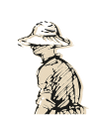Understanding your soil with bio-indicator plants
Soil DiagnosisThe Inventory There are a few pitfalls to avoid: - Be careful when choosing the location for the inventory. By general observation, carefully check the homogeneity of the plot and divide it into zones if it seems heterogeneous. - A few scattered plants are not significant, just as plants are only indicative for the few square decimeters they cover. Especially since gardeners like us, easily annoyed by the two or three unremovable docks, or the few areas invaded by bindweed, tend to overestimate them. - Avoid doing this analysis in winter, when many Poaceae and annuals have disappeared or when the relative absence of aerial parts hinders identification. This precaution also applies to mowed or cut areas. Identifying wild flora is not easy. While the amateur can find his way around species descriptions, distinguishing varieties is much more complex. This aspect is nevertheless very important. The three most common varieties of plantain, for example, each reflect a completely different environment. A bad identification will be a source of error. It is therefore necessary to take one's time, observe at length and above all to use the fauna or description sheets as a guide. The coverage rate Once the inventory is completed, establish the coverage rate of each species. Then assign each a coefficient of this rate: 100%: coefficient 5; 75%: coefficient 4; 50%: coefficient 3; 25%: coefficient 2; - of 25% but with a significant presence: coefficient 1; A few scattered plants: the + sign. Each species having been assigned a number, the analysis can begin. Opposite each one, we note the characteristics of each weed, and it is the addition of these indices that can then help us establish an accurate diagnosis. What do these plants teach us? Chosen because they are quite common in our vegetable gardens, the following descriptions are taken from the files produced by Gérard Ducerf. These few examples, if they are not sufficient to draw definitive conclusions, already allow us to get an idea of a soil and will perhaps give you the desire to go further in the analysis. Couch grass (Elytrigia repens) Every gardener has had the opportunity at least once in his life to come into contact with this perennial Poaceae with long creeping rhizomes and their extraordinary capacity for multiplication. If its primary biotope was the alluvial sands of rivers and streams, its secondary biotope has become that of intensively cultivated fields, vineyards, orchards and long-cultivated gardens, hedges and road embankments, canal, river and stream embankments. What does couch grass teach us? Soil fatigue or degeneration due to successive plowing, excess nitrate and potash, compaction of high pH silty soils, and a strong water contrast. Field bindweed (Convolvulus arvensis) Raise your hand if you don't have it in your vegetable garden! How difficult it is to avoid this annoying invasive plant, which is further multiplied by the use of rotary tools. This convolvulaceae with pretty white or pink flowers has its primary biotope in alluvial valleys saturated with nutrients. Cultivated land and gardens, roadsides, and disturbed wastelands constitute its secondary biotope. What does bindweed tell us? Bindweed indicates saturation of the clay-humic complex with nitrogen. There is also an excess of ammonium nitrate or organic matter and soil compaction. Dandelion (Teraxacum officinale) What can this perennial Asteraceae, with its pretty, bright yellow flowers and seeds that fly in the wind, teach us? Native to natural meadows in plains and mountains and limestone and basalt plateaus, it has a fairly extensive secondary biotope: agricultural meadows, vineyards, orchards, roadsides, etc. What can the dandelion teach us? Dandelion indicates waterlogging of the soil with organic matter, blockage by cold and compaction. As long as it is not dominant, it is a good indicator of rich meadows. Purslane (Portulaca oleracea) This pretty annual plant lying almost entirely on the ground and resembling a succulent is native to India. This portulaceae has as its primary biotope the sands and silts of alluvial valleys. A heat-loving plant, it is generally found in the south of France, but also further north in warm microclimates. Its secondary biotope is quite extensive: cultivated fields, vineyards, orchards, market gardens, family gardens, wastelands, roadsides and paths. What can we learn from purslane? The presence of purslane in our gardens is rich in lessons: soil with low retention capacity, erosion and leaching of bare soil, compaction and compaction of the soil. The blunt-leaved dock (Rumex obtusifolius) Any gardener who has tried to pull out this dock will surely remember the experience! How can such a root be removed? The extremely long and powerful taproot makes the operation almost impossible. It is interesting to note that this dock was extremely rare at the beginning of the 20th century and is now a very common weed. Originally, it was a plant of wet mud and silt, marshes and peat bogs. Today it is frequently found in meadows.






